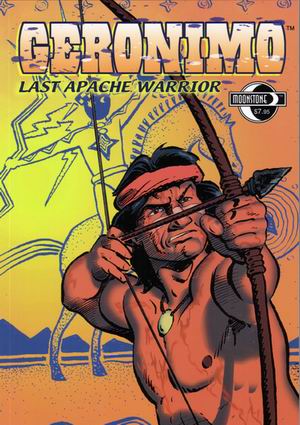I just came across a 2005 graphic novel on Geronimo. I looked it over in my local shop but didn't get it. The following
review by Jim Witt reflects my views on it.
With Geronimo: The Last Apache Warrior, Moonstone Books adds another figure from American Western mythology to its roster of Western icons, a lineup that already includes Wyatt Earp, The Cisco Kid, and Belle Starr. The Last Apache Warrior is a 64-page graphic novel that lives up to what I've come to expect from Moonstone's books, both in terms of their willingness to publish "genre" material that isn't aimed squarely at the mainstream, and the occasional sloppiness and the lack of polish that is often evident in their finished product.
"Call me Goyahkla," says an aging Geronimo, addressing the reader in the narrative's opening line. The first segment of the book is framed as a series of stories told to a member of Geronimo's last band of fighting men, a meagre group of 16 warriors facing its final battle. In the second chapter, the story is continued in the form of an epic-style poem, and in the final pages, a series of full-page drawings accompanied by "headlines" and narration paints the further history of Geronimo and his people. It's an interesting concept, and given a stronger, more focused plot and less self-indulgent writing (particularly in the poetic sequence, which makes a grasp at profundity without capturing it), it's a concept that could have worked. Unfortunately, in the final analysis, it doesn't.As Witt indicates, it's more of a poetic ode to Geronimo than a story about his life. Witt's rating of 2.5/5 seems about right to me. To buy a copy, go to
Geronimo: The Last Apache Warrior.



No comments:
Post a Comment